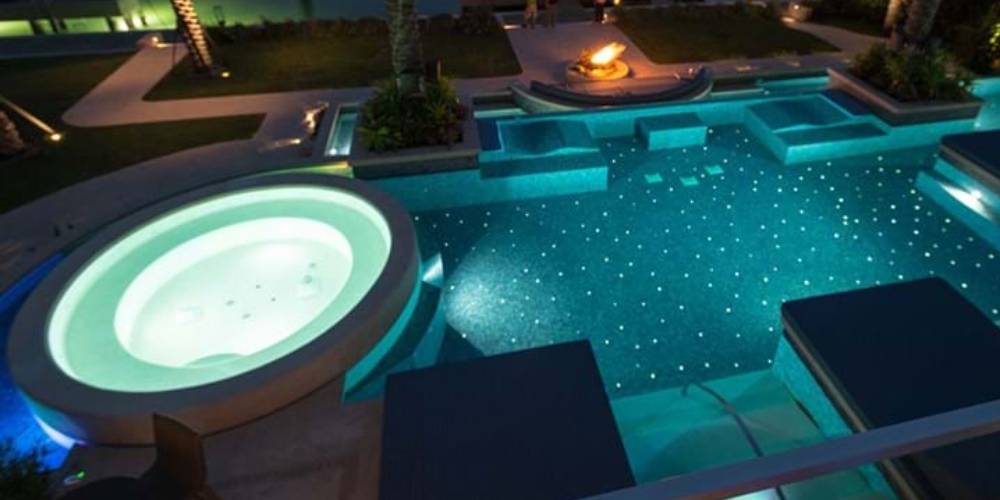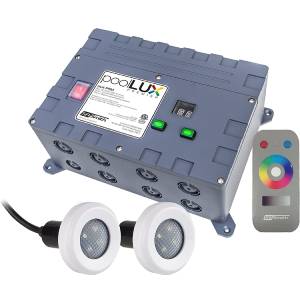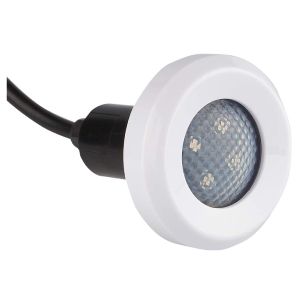- Salt Water Pool and Spa
- Inground Pool Lighting
- Fiber Optics Pool Lighting
Fiber Optics Pool Lighting
Fiber optics pool lighting will produce stunning colors for your pool or hot tub. They are a great way to add a unique vibrance to your pool, deck design or enhance a poolside water feature. LED lit fiber optics allows you the freedom to light almost anything including outdoor seating and bar tops. The low voltage light source is also safe as a submersible lighting option for the ultimate in pool water illumination.

A fiber optics light is a
safe and reliable method of lighting. The illuminator is situated away from your pool, which means no electricity or heat near your pool water. The cable
runs underground from the light source to a standard wall fitting in your pool
wall. A proper fitting lens is required to house the cable that will connect to the LED pool light whether it's white, blue, green, red, amber or a display of various light shows.
How Fiber Optic Pool Lighting Works
Fiber optic pool lighting works by utilizing specialized fiber optic cables to transmit light from a remote light source to various points in the pool or adjacent area. The system starts with a light source, typically a LED or halogen lamp located outside the pool area. The light source produces intense light that will be transmitted through the fiber optic cables. Instead of using traditional electric wiring, fiber optic cables merely transmit the light and are made of optically pure glass or plastic surrounded by a protective outer jacket.
The light generated is directed into one end of the fiber optic cable, where it can travel long distances without significant loss of light. The cables can be routed from the light source to multiple locations including underwater due to their waterproof properties. A light fixture is used to distribute the light into the pool and consists of a lens or a device that disperses and focuses the light into the desired pattern, color or effect.
Adjusting the light source and using different fixtures allows for various spectacular effects. This includes ambient lighting, accent lighting and even color changing effects using LED lights. The lighting is typically managed using a controller and remote control of lighting effects, brightness adjustment and lighting sequences. Fiber optic pool lighting offers enhanced safety compared to traditional inground pool lighting that uses electricity as there will be no electrical supply in the immediate pool area.
Fiber Optics Pool Lighting Kit
A fiber optics pool lighting kit will include everything you need to start experiencing the fantastic lighting effects of fiber optic lit LED lighting in and around your pool. The advanced color functionality with PoolLUX by SR Smith is unmatched with color variations and wireless dimming controls. The low voltage light sources are mounted in a corrosion proof wall or post mounted enclosure for easy access. The LED Star Floor kits also include increased fiber cable length up to 50' to allow for more flexibility including pool perimeter lighting.
PoolLUX Premier Fiber Optics Kit with 2 TREO LED LightsIf you click on this link and make a purchase, we may earn a commission. |
Fiber Optic Pool Lighting Components
- Light Source: This is the device that generates the light. It can be an LED (Light Emitting Diode) or a halogen lamp. The light source is usually located outside the pool area and connected to the fiber optic cables.
- Fiber Optic Cables: These cables are specifically designed for transmitting light signals. They consist of a core made of optically pure glass or plastic, surrounded by a cladding material that reflects light back into the core. The cables are available in different types, such as single-mode or multi-mode, which determine the distance and type of light transmission.
- Light Fittings and Fixtures: At the end of the fiber optic cables, there are light fittings or fixtures that disperse and distribute the light into the pool. These fittings can vary in shape and design, such as recessed underwater fixtures, wall-mounted fixtures, or even floating fixtures. They are designed to withstand the wet and corrosive pool environment.
- Connectors and Adapters: These components are used to connect the fiber optic cables together or to connect them to the light source and light fittings. Connectors ensure a secure and reliable connection, allowing the light to be transmitted without loss or interruption.
- Control System: In more advanced setups, a control system can be included to manage and customize the lighting effects. This may include a control panel, remote control, or even integration with smart home systems. The control system allows for adjusting brightness, color, and creating dynamic lighting sequences.
- Power Supply: Fiber optics pool lighting systems typically require a power supply to provide electricity to the light source and any associated control systems. The power supply should be located in a safe and dry location away from the pool area.
- Mounting and Installation Hardware: Various mounting and installation hardware, such as brackets, clamps, and mounting plates, may be required to secure the light source, fixtures, and cables in place. These components ensure stability and proper positioning of the lighting system.
SR Smith TREO LED Pool Replacement LightIf you click on this link and make a purchase, we may earn a commission. |
Fiber Optics Pool Lighting Installation
- Design and Planning: Assess the lighting requirements and desired effects for the pool. Determine the number and placement of light fixtures based on pool size and shape. Select appropriate fiber optic cables, connectors, and light fittings.
- Preparing the Pool: Ensure the pool is clean and free from debris. Turn off all power sources to ensure safety during installation.
- Mounting the Light Source: Install the light source (LED or halogen lamp) in a dry and well-ventilated location outside the pool area. Connect the light source to the power supply according to the manufacturer's instructions.
- Routing the Fiber Optic Cables: Plan the cable routing path from the light source to the desired fixture locations.Choose the most efficient and aesthetically pleasing route, considering any obstacles or structural elements. Securely attach the cables using appropriate mounting hardware and clips.
- Installing Light Fixtures: Position the light fixtures in the desired locations within the pool. Ensure the fixtures are designed for underwater use and are securely mounted.Connect the fiber optic cables to the fixtures using compatible connectors.
- Waterproofing and Sealing: Apply waterproofing materials, such as gaskets or seals, at cable connections and fixture openings to prevent water ingress. Double-check all connections to ensure they are secure and properly sealed.
- Testing and Troubleshooting: Turn on the power supply and light source. Verify that the light is properly transmitted through the fiber optic cables and emitted by the fixtures. Check for any issues such as dim or flickering lights, and troubleshoot accordingly.
- Final Adjustments and Fine-tuning: Make any necessary adjustments to the positioning and alignment of the fixtures to achieve the desired lighting effects. Test different colors or effects if applicable, ensuring they are functioning as intended.
- Safety Measures and Compliance: Ensure that the installation complies with electrical safety regulations and local building codes.Securely fasten and conceal cables to minimize tripping hazards. Install appropriate signage or warnings for electrical equipment near the pool area.
- Maintenance and Care: Regularly inspect and clean the fiber optic cables, connectors, and fixtures to maintain optimal performance. Replace any faulty components promptly to ensure the longevity of the system.
SR Smith Fiber Optics LED Lighting TransformerIf you click on this link and make a purchase, we may earn a commission. |
Fiber Optics Pool Lighting FAQs
How much does fiber optics pool lighting cost?
How much does fiber optics pool lighting cost?
The cost can vary depending on factors such as the size of the pool, desired lighting effects and complexity of the installation.
How do I install fiber optics pool lighting?
How do I install fiber optics pool lighting?
Installation involves mounting the light source outside the pool area, routing the fiber optic cables to the desired locations and connecting the light fixtures. It's important to follow manufacturer instructions and consider consulting a professional installer for proper and safe installation.
What are the benefits of using fiber optics for pool lighting?
What are the benefits of using fiber optics for pool lighting?
Fiber optics offer advantages such as improved safety due to no electricity near water, energy efficiency, versatility in design and lighting effects even in harsh pool environments.
Can I retrofit my existing pool with fiber optics lighting?
Can I retrofit my existing pool with fiber optics lighting?
It is possible to retrofit an existing pool light system but it may require some modifications and additional installation work. The feasibility depends on the pool's construction and accessibility for cable routing.
How do I control the color and effects of fiber optics pool lighting?
How do I control the color and effects of fiber optics pool lighting?
Color and effects control for fiber optics can be achieved through a control system. You can adjust colors, brightness and create lighting sequences typically via a remote control, control panels or integration with smart home systems.
Disclaimer
Please use all appropriate and proper safety precautions when attempting projects on this website. All projects are attempted at the reader's own risk.
Salt Water Pool and Spa™ participates in the Amazon Services LLC Associates Program, as an Amazon Associate we may earn a commission from qualifying purchases.


